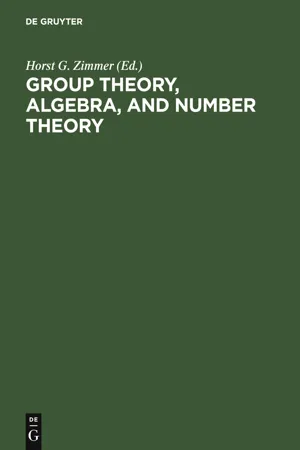
This is a test
- 221 pages
- English
- PDF
- Available on iOS & Android
eBook - PDF
Group Theory, Algebra, and Number Theory
Book details
Table of contents
Citations
Frequently asked questions
At the moment all of our mobile-responsive ePub books are available to download via the app. Most of our PDFs are also available to download and we're working on making the final remaining ones downloadable now. Learn more here.
Both plans give you full access to the library and all of Perlego’s features. The only differences are the price and subscription period: With the annual plan you’ll save around 30% compared to 12 months on the monthly plan.
We are an online textbook subscription service, where you can get access to an entire online library for less than the price of a single book per month. With over 1 million books across 1000+ topics, we’ve got you covered! Learn more here.
Look out for the read-aloud symbol on your next book to see if you can listen to it. The read-aloud tool reads text aloud for you, highlighting the text as it is being read. You can pause it, speed it up and slow it down. Learn more here.
Yes, you can access Group Theory, Algebra, and Number Theory by Horst G. Zimmer, Horst G. Zimmer in PDF and/or ePUB format, as well as other popular books in Mathematics & Mathematics General. We have over one million books available in our catalogue for you to explore.
Information
Table of contents
- Introductory address
- After-dinner speech
- On the solvability of the kernel of any orthogonal decomposition
- 1. Introduction
- 2. Lie algebras of types Bn,Cn, and Dn
- 3. Exceptional Lie algebras
- 4. Lie algebras of type An
- References
- The beginnings of modular Lie algebra theory
- 1. Introduction
- 2. Zassenhaus algebra
- 3. Lie algebras of Cartan type
- 4. Derivations
- 5. Sandwiches, filiations, ‘classicality’ criterion
- 6. Linear representations and Cartan prolongations
- 7. Lie algebras over fields of small characteristic
- 7.1. Characteristic p = 5
- 7.2. Characteristic p = 3
- 7.3. Characteristic p = 2
- 8. Miscellaneous
- References
- Computing invariants of algebraic number fields
- 1. Introduction
- 2. Galois groups
- 2.1. (B) Approximation of Γ from below
- 2.2. (A) Approximation of Γ from above and verification
- 3. Integral basis
- 3.1. Round 2-method
- 3.2. Round 4-method
- 4. Unit group and class group
- 4.1. Method I (assuming GRH)
- 4.2. Method II (unconditional)
- 5. Examples and applications
- References
- Kristallographische Gruppen
- 1. Einleitung
- 2. Die Periode bis 1950 aus heutiger Sicht
- 3. Die vierdimensionalen Raumgruppen
- 4. Spätere Entwicklungen
- 5. Beispiele von Bravaismannigfaltigkeiten
- Literatur
- Endliche Fastkörper und Zassenhausgruppen
- 1. Einleitung
- 2. Zur Kommutativität endlicher Divisionsringe
- 3. Gruppen mit Partition
- 4. Mehr über fixpunktfreie Operation
- 5. Gruppen mit pq-Bedingung
- 6. Ausnahmecharaktere und der SL2(5)-Satz von Zassenhaus
- 7. Das Isomorphieproblem
- 8. Die 2-dimensionalen linearen Gruppen und der SL2(5)-Satz von Dickson
- 9. Vollständige Fastkörper
- 10. Zassenhausgruppen
- Literatur
- On the arithmetic of commutative group rings
- 1. Introduction
- 2. Constructible units
- 3. Cyclic p-groups
- 4. Functors on cyclotomic algebras
- 4.1. Admissible functors
- 4.2. Cyclogenic functors
- 5. Local units and logarithms
- 5.1. Polarized bases
- 5.2. ogarithms and applications
- 6. Regular primes
- 6.1. Arithmetical background
- 6.2. Abelian p-groups
- 7. Irregular primes
- 7.1. A converse
- 7.2. Non-constructible units
- 8. Local units and global ideal classes
- 8.1. Normal bases for local units
- 8.2. Comparison with global units
- 8.3. Kernel groups
- 9. Cyclic groups of composite order
- 9.1. An exact sequence
- 9.2. Even order
- 9.3. Odd order
- References